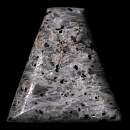|
Click on a letter above to view the list of gems. |
|
|
|
|
|
|
|
|
Wollastonite
(Wollastonite-1A
or Wollastonite-1T)
|
|
| | |
| Discovered in 1818. IMA status: Valid (pre-IMA; Grandfathered) | ||
|
| ||
|
Chemistry |
|
|
| |
|
CaSiO3 | |
|
|
Calcium Silicate |
|
Molecular Weight: |
116.16 gm |
|
Composition: |
Calcium |
34.50 % |
Ca |
48.28 % |
CaO |
|
|
Silicon |
24.18 % |
Si |
51.72 % |
SiO2 |
|
|
Oxygen |
41.32 % |
O |
|
|
|
|
|
100.00 % |
|
100.00 % |
= TOTAL OXIDE |
|
|
|
||||
|
Classification |
|
|
| |
|
Silicates (Germanates) | |
|
8/F.18-10 | |
|
|
9 : SILICATES (Germanates) |
|
Related to: |
Wollastonite Group. Polytypes: Wollastonite-1A, Wollastonite-2M, Wollastonite-3A, Wollastonite-4A, Wollastonite-5A, Wollastonite-7A. |
|
Varieties: |
Edelfarse, Manganoparawollastonite |
|
Synonyms: |
Aedelforsite (of Beudant), Gillebachite, Gillebäckite, Gjellebäckite, Grammite, Okenite (of Rink), Parawollastonite, Rivaite, Tabular Spar, Vilnite, Wollastonite (of Léman) |
|
|
|
|
Crystal Data |
|
|
|
|
|
Crystals tabular || {100} or {001}, or short to long prismatic, to 20 cm. Commonly cleavable, parallel fibrous, or compact, massive. |
|
|
Common; twin axis [010], composition plane {100}. |
|
|
|
|
|
Physical Properties |
|
|
|
|
|
{100} perfect; {001} and {102}, good; (100) ^ (001) =84.5° |
|
|
Irregular/Uneven |
|
|
Brittle |
|
|
4.5 - 5.0 |
|
|
2.86 - 3.09 (g/cm3) |
|
|
Some speciments are Fluorescent; SW UV = bright orange. May exhibit yellow catholuminescence. |
|
|
Not Radioactive |
|
|
|
|
|
Optical Properties |
|
|
|
|
|
White, Colorless, Brown, Red, Yellow, pale Green; Colorless in thin section. |
|
|
Transparent to Translucent |
|
|
Vitreous, Pearly on cleavages |
|
|
1.615 - 1.662 Biaxial ( - ) |
|
|
0.0140 - 0.0160 |
|
|
Weak to Distinct; r > v |
|
|
None |
|
|
|
|
|
Occurances |
|
|
|
|
|
Geological Setting: |
Common in thermally metamorphosed siliceous carbonates, the intruding igneous rock, and skarn deposits along their contact; also in some alkalic igneous rocks and carbonatites. |
|
Common Associations: |
Calcite, Grossular, Diopside, Vesuvianite, Akermanite, Merwinite, Larnite, Spurrite |
|
Type Locality: |
n/a |
|
Year Discovered: |
1818 |
|
View mineral photos: | |
|
|
|
|
More Information |
|
|
|
|
|
| |
|
|
|
|
Wollastonite is named for the English chemist and mineralogist W. H. Wollaston (1766 - 1828). Its actual mineralogical name is Wollastonite-1T. The 1T is for the Triclinic symmetry of the most common and first described Wollastonite mineral. The reason the 1T is needed is to distinguish it from the much more rare Wollastonite-2M, also known as Parawollastonite. Parawollastonite is Monoclinic. These minerals are polymorphs which means that they have the same chemistry, CaSiO3, just different structures (poly means many and morph means shape). There are actually several other rare and obscure polymorphs of CaSiO3 and are given the proposed names of Wollastonite-3T, Wollastonite-4T, Wollastonite-5T and finally Wollastonite-7T. All specimens named just Wollastonite are most likely Wollastonite-1T. Wollastonite
is a widely distributed mineral; some prominent localities
are: in Romania, at Dognecea and Csiklova, Banat. In
Italy, at Sarrabus, Sardinia, and from Monte Somma and
Vesuvius, Campania. In Ireland, at Dunmorehead, Mourne
Mountains, and Scawt Hill, near Larne, Co. Antrim. From
Kongsberg, Norway. At Göckum, Sweden. In Germany, at
Harzburg, Harz Mountains, and Auerbach, Odenwald, Hesse.
In the USA, at Natural Bridge and Diana, Lewis County,
New York; from Crestmore, Riverside County, and Darwin,
Inyo County, California; in a large deposit two miles
southeast of Gilbert, Esmeralda County, Nevada. In Canada,
at Oka and Asbestos, Quebec; at Outlet Post, Leeds County,
Ontario. From Pichucalo, Chiapas, and in the Pilares
deposit, 55 km north of Hermosillo, Sonora, Mexico.
At Hiiagiyama, Ibaragi Prefecture; Ishiyamadera, Shiga
Prefecture; and Kushiro, Hiroshima Prefecture, Japan.
Large crystals from Belafa, Madagascar. |
|
|
We
have not photographed our Wollastonite gems
yet. Please
check back soon. |
